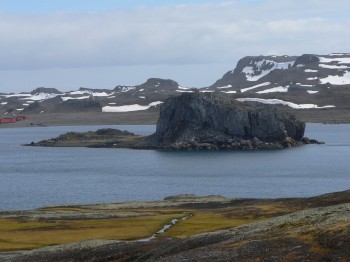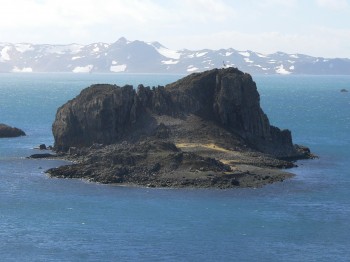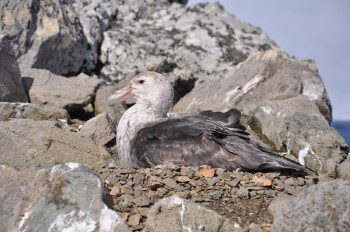Diomedea Island is a small rocky elevated island situated in Ardley Cove, Maxwell Bay between Ardley Island and the Fildes Peninsula of King George Island (KGI). It forms part of the South Shetland Islands off the western coast of the Antarctic Peninsula. In low areas moss beds and algae are present with lichens occurring on the more elevated rocks.



Three views of Diomedea Island
Close by on the peninsula lie the Chilean Base Presidente Eduardo Frei Montalva and the Russian Bellingshausen Station.
From the 1979/80 summer season to 2013/14 from nil to 17 pairs of Southern Giant Petrels Macronectes giganteus have been recorded breeding on the island, with the latest season yielding 10 pairs.

A Southern Giant Petrel on its nest on Diomedea Island
Photographs by Christina Braun
The island was originally named Ostrov Al'batros (Albatross Island, or Isla Albatros in Spanish) by the Soviet Antarctic Expedition of 1968, but was changed to Diomedea in 1979 to avoid confusion with an Albatross Island elsewhere within the general region. However, albatrosses do not occur and so perhaps Macronectes Island would have been a more appropriate name.
Diomedea Island is located in the direct line of the approach path of the Chilean Teniente Rodolfo Marsh Martin Aerodrome. Low overflights were common in the past but have been greatly strongly reduced since 2003/04. The island also lies close to anchoring grounds used by supply, cruise and patrol vessels. Diesel resupply to Presidente Eduardo Frei Montalva takes place via an underwater pipeline close by. Only occasional visits are made by station personnel; it is not a site where tourism occurs.
Selected Literature:
Braun, C., Hertel, F., Mustafa, O., Nordt, A., Pfeiffer, S. & Peter, H.-U. 2013. Environmental situation and management challenges for the Fildes Peninsula Region. In: Tin, T., Liggett, D., Maher, P. & Lamers, M.E. (Eds). The Future of Antarctica: Human Impacts, Strategic Planning, and Values for Conservation. Dordrecht: Springer. pp. 169-191.
Braun, C., Mustafa, O., Nordt, A., Pfeiffer, S. & Peter, H.-U. 2012. Environmental monitoring and management proposals for the Fildes Region, King George Island, Antarctica. Polar Research 31. 18 pp.
Patterson, D.L., Woehler, E.J., Croxall, J.P., Cooper, J., Poncet, S., Peter, H.-U., Hunter, S. & Fraser, M.W. 2008. Breeding distribution and population status of the Northern Giant Petrel Macronectes halli and Southern Giant Petrel M. giganteus. Marine Ornithology 36: 115-124 and appendix.
Peter, H.-U., Kaiser, M. & Gebauer, A. 1991. Breeding ecology of the southern giant petrels Macronectes giganteus on King George Island (South Shetland Islands, Antarctic). Zoologisches Jahrbuch Systematik 118: 465-477.
John Cooper, ACAP Information Officer & Christina Braun, University of Jena, Germany, 12 May 2014

 English
English  Français
Français  Español
Español